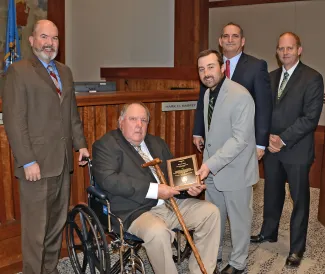
Honoring the 2022 Landowner of the Year are, from left, ODWC Director J.D. Strong, honoree Herman Jones, ODWC Wildlife Technician Nathaniel Kester, ODWC Wildlife Chief Bill Dinkines, and ODWC Private Lands Supervisor Josh Richardson.
The Oklahoma Department of Wildlife Conservation acknowledges Adair County landowner Herman Jones of Stilwell as the 2022 Landowner Conservationist of the Year. This award honors landowners who have exercised outstanding wildlife conservation practices on private property.
Jones, along with his family, have owned and managed approximately 1,300 acres in southeastern Adair County, near the community of Bell, for many years. This property is predominately oak/hickory forest indicative of the Ozark Highlands of the northeastern part of the state. When he first started working on his property it looked much like the rest of that part of the county, thick underbrush with a dense, closed canopy in dire need of management.
Approximately 12 years ago, Herman enrolled about 800 acres of the property into a Natural Resources Conservation Service program, the Healthy Forests Reserve Program. This program was aimed at promoting the recovery of threatened and endangered species through habitat management. Southern Adair County is home to the federally endangered Ozark big-eared bat to which Herman was able to enroll his property to help restore the habitat back to a more favorable environment. The hack-and-squirt method was utilized, according to a prescription, to thin the timber on his property down to allow better access and flyways for the endangered bat. Fireguards were then put in place to allow prescribed burns to be put on the landscape to keep succession set back after the thinning project. Even though this program was aimed at the big-eared bat, all wildlife has benefited greatly from this thinning/burn regime Herman has started. Herman has also been in the EQIP program building ponds and planting grasses. He also has drilled wells and placed stock tanks utilized both by livestock and wildlife through the state cost share programs.
With Herman’s conservation practices in place, he has seen a great response from deer and especially turkeys. Native forbs and grasses are being promoted with the sunlight now being able to hit the forest floor. Now with the thinned canopy, large mast producing trees have ample resources needed to produce, not being choked out by the excess timber and closed canopy. About 20 acres of food plots are also planted annually on the property normally to wheat, turnips or oats. Occasionally soybeans will also be planted during the growing season to draw deer onto the property. Herman’s family has a deep tradition of hunting and he encourages that same tradition today on his property with his children, grandchildren and now great-grandchildren.
Herman has shown no matter how rough or rugged a property may be, a little bit of habitat management goes a long way for the benefit of wildlife. Congratulations to Herman Jones for being selected as the 2022 ODWC Landowner Conservationist of the Year.